Geoscience Reference
In-Depth Information
data and a stratigraphic column. This well bedded
sequence of sediments and volcanics is comparatively
undeformed and represents an excellent setting for seismic
re
ection surveys. The data have been depth converted
following pre-stack time migration. The different strati-
graphic units are seen to have distinctly different appear-
ance (character) on the seismic data with stratigraphic
re
ectors, e.g. (1), easily traced across the section. Angular
unconformities are recognisable from the truncation of
underlying dipping reflectors (2). In
Fig. 6.40b
faults are
recognised from offsets in events of stratigraphic origin.
The most common form of display shows trace ampli-
tude, but it is also possible to calculate enhanced forms of
the data (see
Section 2.7.4
). In the case of seismic data, the
results are referred to as attributes, e.g. Manzi et al.
(
2012a
). These may comprise a representation of the fre-
quency or phase information in the trace (see online
Appendix 2
)
. Alternatively, for 3D data, horizons can be
analysed in terms of characteristics such as dip and dip
direction.
Although a migrated zero-offset seismic re
ection
section resembles a geological cross-section, it may be very
dif
cult to relate observed responses to the known geology,
notably depth data from drillhole intersections and, if
available, the mine geology. Every opportunity should be
taken to establish a correlation between the known geology
and the seismic response by calibrating, or
Slowness
( s/ft)
a)
b)
60
160 135 110 85
60
65
Source A
70
Span
75
Span
80
85
Source B
90
Siltstone
Coal
Sandstone
Cemented band
Figure 6.39
Downhole sonic logging. (a) Schematic illustration of a
logging tool. (b) Sonic log through a coal-bearing sedimentary
sequence. The horizontal scale is slowness (1/velocity) measured in
per second, but slowness is often displayed in microsec-
onds per foot (
s/ft), a practice resulting from the con-
tinued use of imperial units by the petroleum industry. The
use of multiple sources and detectors reduces effects
related to changing drillhole conditions.
More sophisticated is full waveform sonic logging which,
in addition to measuring arrival times, records what is
equivalent to a seismic trace. This allows different types
of waves to be recognised and additional seismic properties
to be determined, e.g. attenuation. Good descriptions of
and in a hard-rock context, by Schmitt et al.(
2003
).
μ
'
tying
'
6.7.1
Resolution
Seismic reflection sections and volumes constitute the most
detailed representations of the subsurface that can be
created using geophysical methods. Moreover, the display
of the data resembles a picture of the subsurface. When
interpreting these data it is particularly important to have
an appreciation of the resolution of the data so as not to
over-interpret them. As will be demonstrated below, the
size of resolvable features in the subsurface is orders of
magnitude larger than those that might be recognised in
exposures or drillcore.
Seismic resolution is normally quanti
ed in terms of
lateral and vertical resolution. In both cases the dominant
wavelength of the data is the controlling parameter (see
Section 6.3.2
). Recall that for two distinct arrivals to be
recognisable within a seismic trace, their travel times
should differ by more than half the dominant period of
6.7
Interpretation of seismic reflection data
The interpretation of seismic re
ection data is mostly a
qualitative process based on the recognition and mapping
of re
ective horizons. Single 2D dip-pro
les may be
recorded across features of interest, but to determine the
structure of a region properly, a network of intersecting
survey lines is required. Features that can be reliably recog-
nised are correlated across the seismic sections to build up a
3D map of their form. These may be stratigraphic horizons,
stratigraphic intervals or structures such as faults.
Figures 6.40
and
6.41
show seismic data from the Wit-
watersrand Basin in South Africa.
Figure 6.40a
shows some








































































































Search WWH ::

Custom Search